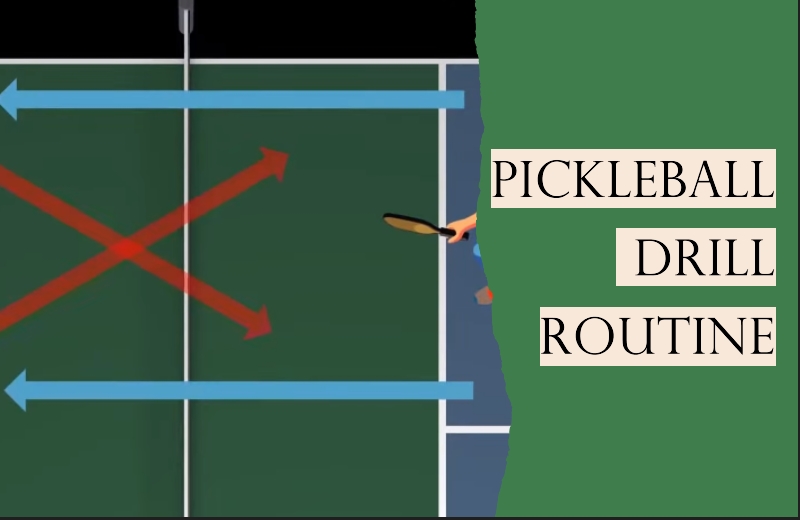Key Takeaways:
- Warming Up: Begin with Diagonal Court Play and Twisty Taps to prep muscles and mind.
- Skill Sharpening: Refine techniques with Drop Shots and Rhythmic Routines.
- Kitchen Conquests: Focus on quick reactions and strategic net play with Rapid Response and Speedy Strikes.
- The Final Countdown: Master serves with Serve it Up and perfect overheads through Skyward Slams.
Pickleball Drill Routine
Pickleball drill routine is a vital part of training in the sport of pickleball, involves repetitive exercises designed to enhance skills. Players engage in this drill routine to improve accuracy, agility, and control. A typical routine might include volley drills, serving practice, and footwork exercise. By focusing on specific aspects of the game, a player can hone their abilities, making them more adept at playing pickleball. It’s a nifty way to get better at the game, ain’t it?
Professional Techniques: Drill Routine Origins.
- Pickleball drills are not randomly selected; they’re curated from the expertise of top pro players and instructors like Simone Jardim, Steve Deakin, Catherine Parenteau, and Dekel Bar.
- Following these pickleball drills means adopting techniques and strategies used by the best in the sport.
- Authenticity in training: By drilling these pickleball drills, players align their training methods with those of pickleball champions, ensuring they’re on the right path.
Phase 1: Warming Up
Before diving into pickleball drills, warm-up ain’t just about getting the blood pumping. It’s about setting the stage for a killer session. So, let’s get that body movin’ and groovin’!
Diagonal Court Play: Full-Court Taps (10 Minutes)
- Full-Court Dinking: This ain’t your grandma’s dinking session. Start with diagonal dinking, each player on even side for 5 minutes. Then, switch it up. Odd side, another 5. Aim? Get that ball out of the air, but no overreaching, alright?
- Movement: Keep those feet shuffling. Move your opponent around, hit different areas, and mix up those forehand and backhand dinks. Remember, it’s all in the footwork.
Twisty Half-Court Taps: First A, Next B (10 Minutes)
- Figure-8 Dinking: Player A, you’re up with diagonal dinks. Player B, you’re going straight ahead. After 5 minutes, y’all switch. Keep the rhythm, and remember to move without overreaching.
- Positioning: After each dink, get back to that neutral body position. It’s all about being ready for the next move.
Breather: Swap and Stretch (5 Minutes)
Rest and Rotate: After those intense pickleball drills, give those muscles a breather. Stretch it out, chat with your partner, and hydrate. But keep it snappy; we’re just getting started!
Phase 2: Skill Sharpening
Sharpening your skills in pickleball isn’t just about hitting the ball; it’s about mastering the rhythm, understanding the pickleball court, and predicting your opponent’s next move. Let’s dive deeper into some drills that will help you elevate your pickleball game.
All-Around Drop Shots: A/B Dance (15 Minutes)
- Baseline Drops: One player stands just behind the baseline, while the other person remains behind the kitchen line. The baseline player focuses on hitting precise drops into the kitchen. The kitchen player, on the other hand, sends balls bouncing out in front of the baseline player. After 7 minutes, switch roles.
- Crosscourt Forehands: Both players position themselves on the deuce side. The baseline player should practice their drops, while the kitchen player decides which balls to volley and which to let bounce. Swap roles after 7 minutes.
- Backhand Drops: Now, move to the ad side. The baseline person gets a chance to practice pickleball drill that is backhand drops, aiming for long rallies with successful drops. Remember, no hard drives; it’s all about control and precision.
Rhythmic Routine: Tap Trio, Skyward, Plunge (5 Minutes)
- Tap Trio: Engage in a three-shot rally, focusing on control and placement. It’s not about power; it’s about precision.
- Skyward: Introduce a lob into the rally. The aim? Send your opponent scrambling back, creating space in the kitchen.
- Plunge: Finish the rally with a drop shot, plunging the ball into the kitchen, forcing your opponent to make a difficult return.
Time Out: Rotate and Reflect (5 Minutes)
- Hydrate and Breathe: Grab a sip of water, take deep breaths, and reset. It’s essential to keep the body hydrated and the mind sharp.
- Reflect: Discuss with your partner about the shots that worked and those that didn’t. Sharing insights can lead to better strategies and improved gameplay.
Phase 3: Kitchen Conquests
Rapid Response: Half-Court Strikes (5 Minutes)
- Dink Dynamics: Engage in diagonal dinking. Aim for both forehand and backhand dinks.
- Movement Mastery: Focus on lateral movement. Return to a neutral position after each dink.
- Air Strikes: Whenever feasible, snatch balls out of the air without overreaching.
Tap, Ambush, Cool Down (5 Minutes)
- Volley Ventures: Stand at your kitchen lines. Initiate with slow volleys, then escalate the pace.
- Rally Rhythms: Collaborate to maintain the rally. Return to a ready stance after each volley.
- Balance Act: Place an object, maybe a wristband, on your noggin. Limit excessive movement.
Speedy Strikes: First A, Then B (10 Minutes)
- Dink Duel: Stay alert for balls ripe for attack. If it’s high, go for a speed-up attack.
- Reset Ritual: If attacked, dodge or neutralize the pace. Aim for a soft return over the net.
- Drive Dynamics: One player near the service line, the other at the kitchen. Practice routine drives and volleys.
Advancing Points: A/B Challenge (5 Minutes)
- Feed and Forge: One player feeds the ball, the other advances using drives or shot drop.
- Deep Defense: The feeder aims to volley returns as deep as possible, keeping the advancer at bay.
- Point Play: Play out the point with dinks, attacks, counterattacks, and resets.
Breather: Swap and Sip (5 Minutes)
- Hydration: Take a moment to sip some water. Hydration remains crucial.
- Swap Spots: Change your position on the court. Get a fresh perspective.
- Reflect: Ponder on the drills. Think about areas of improvement and strategies to implement next.
Phase 4: The Final Countdown
Serve it Up: A/B Duel (5 Minutes)
- Cross-Court Diagonals: Engage in full-court dinking. For 5 minutes, diagonal dinking with each player on even side of the pickleball court. Then, switch it up. Aim for variety, moving your opponent around. Remember, footwork remains crucial.
- Figure-8 Half-Court Dinking: One player dinks diagonally, the other straight across. After 5 minutes, swap roles. Keep your feet moving and pickleball paddle ready. Stay alert.
Skyward Slams: A/B Showdown (5 Minutes)
- Kitchen Line Volleys: Stand firm at your kitchen lines. Start slow, then ramp up the speed. Aim for consistency and control. Keep that rally alive.
- Dink, Attack, Reset: Stay on your toes. If a dink comes high, speed it up. On the receiving end? Either dodge or reset with a soft block. Keep the rally going, and remember, strategy wins games.
Beyond Routine: Drill Benefits
- Each shot drill is multifaceted, offering benefits that go beyond the obvious.
- “Skinny Singles” drill:
- Primary Benefit: Enhances shot accuracy.
- Hidden Benefits: Boosts footwork, increases court awareness, and teaches players to anticipate opponent’s moves.
- “3-player cutthroat” drill:
- Primary Benefit: Mastery over serves.
- Hidden Benefits: Understanding the rhythm of the game, predicting opponent’s next moves, and strategizing returns.
- Recognizing these layered benefits can provide players with deeper insights and motivations to practice pickleball workout diligently.
Court Pitfalls: Avoiding Common Mistakes.
- Even seasoned players can fall into certain bad habits; being aware is the first step to rectification.
- Common mistakes in the “Serve and Return” drill:
- Overemphasizing power, leading to loss of control.
- Neglecting the importance of shot placement, making it easier for opponents to return.
- In the “Dink, Dink, Lob, Drop” routine:
- Players often rush the lob, compromising on accuracy.
- The initial dinks, crucial for setting up the lob, are sometimes overlooked.
- By being cognizant of these pitfalls, players can adjust their practice drills to focus on areas of improvement and avoid ingraining bad habits.
FAQs
What 3 skills do you need to be successful in pickleball?
What are the 4 P’s of pickleball?
What do you find most difficult when it comes to playing pickleball?
Conclusion
Pickleball, a blend of tennis and table tennis, offers endless excitement. With the right drills, your game can soar to new heights. Dedication and consistent practice are your tickets to mastery.


